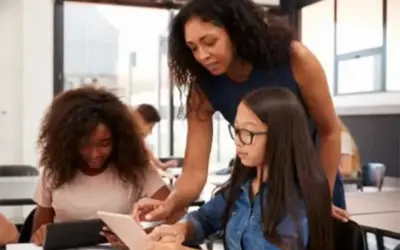Adaptive learning has long been a staple in educational technology. I took the GRE more than 20 years ago, for example, which was when the computer-administered exam first started using algorithms that adjusted subsequent test questions based on the test-taker’s performance on prior ones, following a string of correctly-answered questions with more challenging ones, and vice-versa. Many of the current assessments that our students take (e.g., NWEA’s MAP testing) are similarly equipped with such technology to better assess their performance. Likewise, beginning in 2024 the SAT will use adaptive technology to adjust its test based on student performance. One year, I taught six classes of Algebra I and had to use different end-of-unit tests for the various classes, depending on the mathematical content which we had covered in each class. Adaptive learning technologies are able to do this in real time, and then provide immediate feedback to students and teachers. And now the rise of artificial intelligence (AI) has the potential to make these technologies even more powerful.
Google defines AI as “the theory and development of computer systems able to perform tasks that normally require human intelligence, such as visual perception, speech recognition, decision-making, and translation between languages”. In the last few months, articles and commentary on AI seem to be everywhere. On June 7, 2023, Forbes discussed ways that teachers are currently using AI to create lesson plans, analyze data, and “engineer learning interventions.” I myself have had many discussions during the current school year, with my colleagues and students on the topic of ChatGPT, the best-known of the new AI programs. For example, I can simply request it to “give me directions to find the slope of a line.” Here is what it produced.

These directions are mathematically sound and accessible to students. From them I could easily create guided notes or a slideshow. If a teacher is not sure how to teach a certain topic, or needs to create a lesson plan, ChatGPT offers a solution, one never before available to us.
Over the last decade, most big textbook publishers have paired their mathematics curricula with some type of adaptive learning (e.g., McGraw-Hill uses ALEKS), as have many online mathematics practice and test programs. For example, USATestPrep keeps tracks of student performance on each mathematics standard and each group of standards. It then recommends extra practice to students in areas where they are not proficient. In addition, the teacher can look at individual student or class performance by standard, and create their own practice materials for students. This blend of computer-adaptive technology and readily-available performance data can help the teacher evaluate students and plan effective lessons, using both formative and summative assessments.
CollegeReadyMath uses adaptive learning technology to “create customized learning paths for each student to help ensure high school, college and career readiness.” These individualized Algebra lessons help students get additional instruction and practice in the areas where they are not proficient. By focusing on areas where an individual needs help, students are not forced to sit through lessons on content that they already have mastered. Further, CollegeReadyMath allows the teacher to track student progress and collect data to make decisions about how to best provide intervention and enrichment.
The impact of AI on these adaptive learning technologies has yet to be felt. The Forbes article discusses the potential of AI to provide each and every individual student with an “amazing personal tutor.” Schools have not yet begun to grapple with ways to integrate this type of technology into their instruction. My own classroom instruction has benefited from the use of various adaptive learning technologies over the last several years, and I’m eager to explore how AI, in the form of ChatGPT, can help me to design instruction and continue to hone my teaching skills going forward.
In May 2023, the National Council of Teachers of Mathematics published its position statement on “Equitable Integration of Technology for Mathematics Learning”:
Using the capabilities of technology is essential for educators and learners to inform and transform how they learn, experience, communicate, assess, and do mathematics. Technology should be used to develop and deepen learner understanding, stimulate interest in the mathematics being learned, and increase mathematical proficiency. When technology is used strategically, it provides more equitable access and opportunities for each and every learner to actively engage and participate in the learning of mathematics.
Adaptive learning technologies provide us an opportunity to better educate and motivate our students, and to work towards equitable outcomes in mathematics education. The integration of AI into these adaptive learning technologies will prove transformative, and be exciting to witness.







